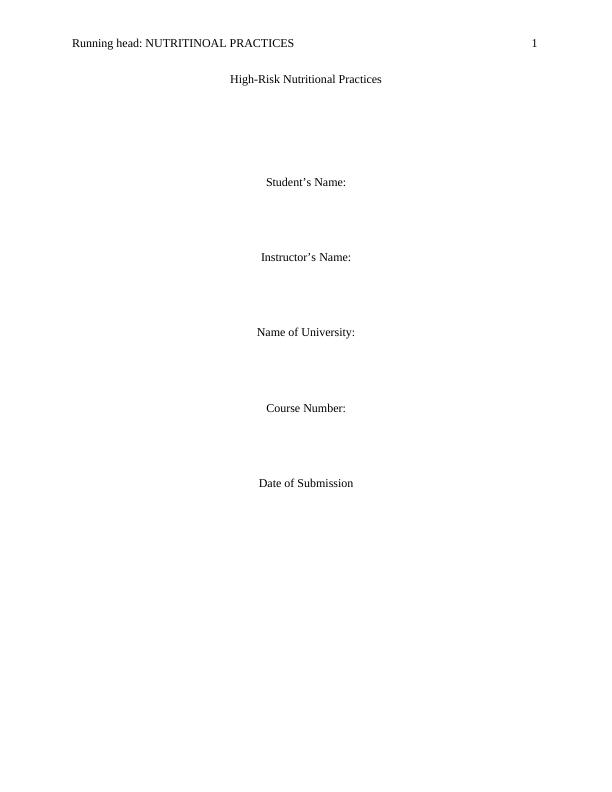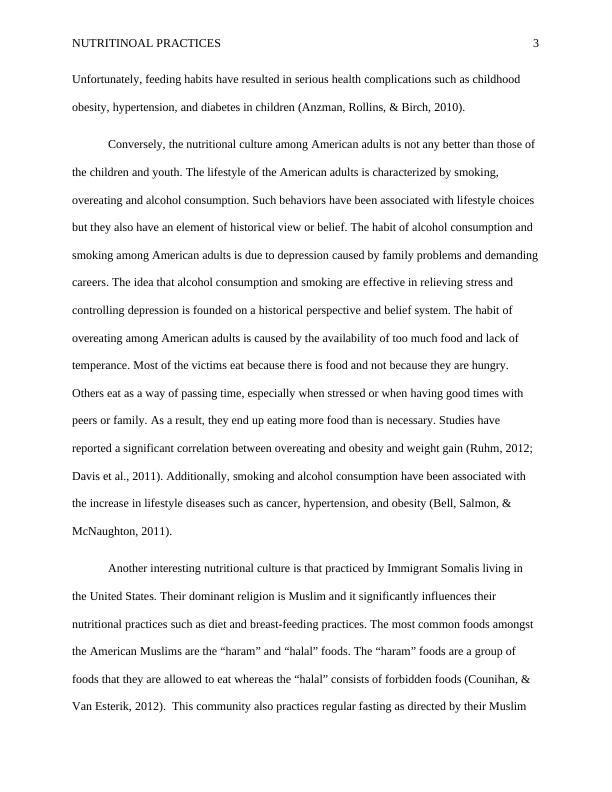Nutritional practices in every culture
Added on 2022-09-16
8 Pages2183 Words23 Views
Running head: NUTRITINOAL PRACTICES 1
High-Risk Nutritional Practices
Student’s Name:
Instructor’s Name:
Name of University:
Course Number:
Date of Submission
High-Risk Nutritional Practices
Student’s Name:
Instructor’s Name:
Name of University:
Course Number:
Date of Submission

NUTRITINOAL PRACTICES 2
There has been a significant shift in the nutritional practices globally. As much as
traditional nutritional practices have been influenced by industrialization, the feeding customs of
people are to a greater extent still influenced by cultures. There is a strong association between
nutrition and culture. Most cultures are distinguished by nutritional behaviors. One of the critical
aspects of culture is its influence on health. Some cultures have healthy nutritional practices
whereas others are detrimental to health. Nutritional practices in every culture are passed down
from generation to generation and are based on some belief systems. The current essay aims at
examining the high-risk nutritional practices across multiple cultures. More specifically, it
explores the high-risk nutritional practices and the historical perspectives, belief systems, in
addition to other aspects that determine nutritional practices of each culture.
The American children have a culture of high-risk nutritional behavior which consists of
the consumption of junk food. There has been observed a significant increase in the number of
American children and youth that habitually consume junk food. Such a risky nutritional
behavior has been influenced by multiple factors. Though, the historical perspective or belief
system associated with such practice has not been explored fully. However, research on the
possible causes and impacts of the high consumption of junk food among American children and
youth have attributed it to industrialization, family roles, promotions, education, and busy
schedules. The practice of producing junk food emerged with industrialization because in the
past most of the family members could eat food prepared at home, and there were minimal fast-
food restaurants, unlike today. But things are different today because most of the time there is no
one at home including the children and also there are fast food restaurants everywhere thus
exposing the children to junk food. The education and busy schedules alongside overtaxing
professions for parents are other reasons for the current feeding habit in children and youth.
There has been a significant shift in the nutritional practices globally. As much as
traditional nutritional practices have been influenced by industrialization, the feeding customs of
people are to a greater extent still influenced by cultures. There is a strong association between
nutrition and culture. Most cultures are distinguished by nutritional behaviors. One of the critical
aspects of culture is its influence on health. Some cultures have healthy nutritional practices
whereas others are detrimental to health. Nutritional practices in every culture are passed down
from generation to generation and are based on some belief systems. The current essay aims at
examining the high-risk nutritional practices across multiple cultures. More specifically, it
explores the high-risk nutritional practices and the historical perspectives, belief systems, in
addition to other aspects that determine nutritional practices of each culture.
The American children have a culture of high-risk nutritional behavior which consists of
the consumption of junk food. There has been observed a significant increase in the number of
American children and youth that habitually consume junk food. Such a risky nutritional
behavior has been influenced by multiple factors. Though, the historical perspective or belief
system associated with such practice has not been explored fully. However, research on the
possible causes and impacts of the high consumption of junk food among American children and
youth have attributed it to industrialization, family roles, promotions, education, and busy
schedules. The practice of producing junk food emerged with industrialization because in the
past most of the family members could eat food prepared at home, and there were minimal fast-
food restaurants, unlike today. But things are different today because most of the time there is no
one at home including the children and also there are fast food restaurants everywhere thus
exposing the children to junk food. The education and busy schedules alongside overtaxing
professions for parents are other reasons for the current feeding habit in children and youth.

NUTRITINOAL PRACTICES 3
Unfortunately, feeding habits have resulted in serious health complications such as childhood
obesity, hypertension, and diabetes in children (Anzman, Rollins, & Birch, 2010).
Conversely, the nutritional culture among American adults is not any better than those of
the children and youth. The lifestyle of the American adults is characterized by smoking,
overeating and alcohol consumption. Such behaviors have been associated with lifestyle choices
but they also have an element of historical view or belief. The habit of alcohol consumption and
smoking among American adults is due to depression caused by family problems and demanding
careers. The idea that alcohol consumption and smoking are effective in relieving stress and
controlling depression is founded on a historical perspective and belief system. The habit of
overeating among American adults is caused by the availability of too much food and lack of
temperance. Most of the victims eat because there is food and not because they are hungry.
Others eat as a way of passing time, especially when stressed or when having good times with
peers or family. As a result, they end up eating more food than is necessary. Studies have
reported a significant correlation between overeating and obesity and weight gain (Ruhm, 2012;
Davis et al., 2011). Additionally, smoking and alcohol consumption have been associated with
the increase in lifestyle diseases such as cancer, hypertension, and obesity (Bell, Salmon, &
McNaughton, 2011).
Another interesting nutritional culture is that practiced by Immigrant Somalis living in
the United States. Their dominant religion is Muslim and it significantly influences their
nutritional practices such as diet and breast-feeding practices. The most common foods amongst
the American Muslims are the “haram” and “halal” foods. The “haram” foods are a group of
foods that they are allowed to eat whereas the “halal” consists of forbidden foods (Counihan, &
Van Esterik, 2012). This community also practices regular fasting as directed by their Muslim
Unfortunately, feeding habits have resulted in serious health complications such as childhood
obesity, hypertension, and diabetes in children (Anzman, Rollins, & Birch, 2010).
Conversely, the nutritional culture among American adults is not any better than those of
the children and youth. The lifestyle of the American adults is characterized by smoking,
overeating and alcohol consumption. Such behaviors have been associated with lifestyle choices
but they also have an element of historical view or belief. The habit of alcohol consumption and
smoking among American adults is due to depression caused by family problems and demanding
careers. The idea that alcohol consumption and smoking are effective in relieving stress and
controlling depression is founded on a historical perspective and belief system. The habit of
overeating among American adults is caused by the availability of too much food and lack of
temperance. Most of the victims eat because there is food and not because they are hungry.
Others eat as a way of passing time, especially when stressed or when having good times with
peers or family. As a result, they end up eating more food than is necessary. Studies have
reported a significant correlation between overeating and obesity and weight gain (Ruhm, 2012;
Davis et al., 2011). Additionally, smoking and alcohol consumption have been associated with
the increase in lifestyle diseases such as cancer, hypertension, and obesity (Bell, Salmon, &
McNaughton, 2011).
Another interesting nutritional culture is that practiced by Immigrant Somalis living in
the United States. Their dominant religion is Muslim and it significantly influences their
nutritional practices such as diet and breast-feeding practices. The most common foods amongst
the American Muslims are the “haram” and “halal” foods. The “haram” foods are a group of
foods that they are allowed to eat whereas the “halal” consists of forbidden foods (Counihan, &
Van Esterik, 2012). This community also practices regular fasting as directed by their Muslim

End of preview
Want to access all the pages? Upload your documents or become a member.
Related Documents
Nutritional Behavior in Adolescencelg...
|6
|1737
|88
Healthy Eating Education for Mothers and Its Impact on Obesity in Children: A Randomised Controlled Triallg...
|16
|4147
|336
Role of Preschool Parents in Child’s Eating Behaviourlg...
|10
|3506
|39
Introduction to Public Health Nursinglg...
|5
|984
|64
Risk Factors Of Heart Diseaselg...
|8
|1936
|17
Social Influences on Food Purchasing Behaviors: A Study on Media and Marketing, Gender Roles and Stereotypes, and Policies and Programslg...
|11
|2797
|57